Libreria Antiquaria Pregliasco II
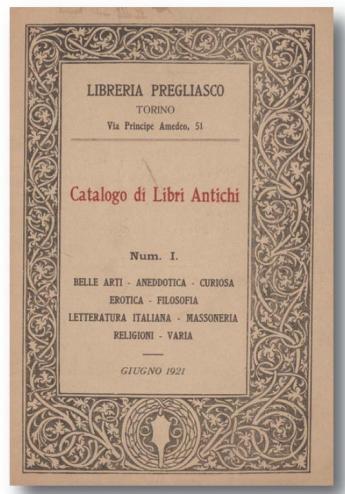
By Umberto Pregliasco
Part 2
The man who does not read good books
has no advantage over the man who can't read them.
(Mark Twain)
Catalogue One, The Adventure Begins
This catalogue, consisting of 34 pages, printed on plain paper in June 1921, for us is just like a “Number One Dime”, a Disney’s good luck charm at the beginning of a long series of publications. The index of subjects is already quite significant: next to fine arts, philosophy, Italian literature and religions, we find, as a matter of fact, unusual entries, such as “anecdotes”, “curiosities”, “erotica” and “freemasonry”. Going through the pages of this family, but also historical, treasure, 90 years after its publication, is really touching. The delicate pages yellowed with dignity, its simple cover in light green wrappers, a little worn out and with a few brown spots, the border surrounding the title - that would have remained as the graphical design for some years to come - make this “elderly and distinguished gentleman” closer to the dust-jacket first editions of the beginning of the century, which are now for sale on the shelves of the bookshop, than to the modern and colourful recently published “colleagues”.
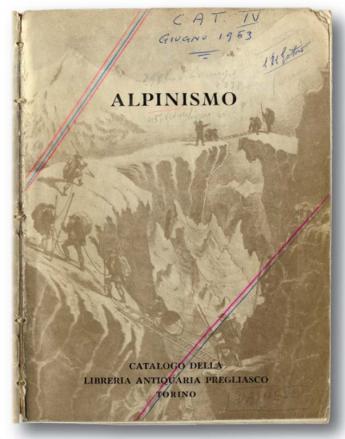
The First Monographic Catalogue And The Love For The Mountains
In 1961, the bookshop moves to its current location, 100 meters far from the original one, across the street from the Institute of Fine Arts, at first on the ground floor, to be later extended to the rooms on the first floor, furnished with antique bookcases. In June of 1963, for the occasion of the one hundred years of the Italian Alpine Club, we publish our first monographic catalogue: Mountaineering (no. 4), gathering a collection of volumes about the Alps, their history and their pioneers. The topic is emblematic, since the Alps are a family passion, which we would have celebrated once again, 43 years (and 86 catalogues) later, for the occasion of the Torino Winter Olympics in 2006 with The Alps through the Centuries.
The motto opening the introduction, “Librorum et Alpium amor nos unit”, is a manifesto, but it is also a testimonial of continuity with the past. Laura and Giorgio Aliprandi continue with this statement: “we must recognize that the psychological, physical and also economical effort sustained by the Pregliascos to gather as much as possible, during these years, on one single topic, the mountaineering. A remarkable endeavour, knowing how little the antique market has to offer on the topic of the Alps. In spite of this, we can say that father and son have reached their purpose: the catalogue is the point of reference for those who would like to get closer to the literature about the mountains, to the level that it can be considered as a reference text to place in a library.… an event that is properly suitable for the celebration of 2006 Winter Olympics and makes Torino a point of reference not only as far as sports but also on the cultural aspect, as far as the mountain related literature”.
The bibliographic expertise and the importance of the collections presented, are a tangible proof of what is the daily work on the object book: a deep study of the work and of the item, besides the strictly business related implications. Any sales catalogue for an antiquarian book dealer is an amazing educational instrument, and the comparison between the two catalogues dedicated to the Alps, published years apart from one another, is a bibliographical resource for scholars, but also for collectors. For example, it is interesting to compare the price of the original edition of the Voyages dans les Alpes by Saussure, offered in both catalogues, for sale in 1963 at the price of 82,000 Italian Lira (about 120 dollars, at the time), and for 9,500 Euro (about 11,000 dollars) in 2006.
I know every book of mine by its smell, and I have but to put my nose between the pages to be reminded of all sorts of things.
(George Robert Gissing)
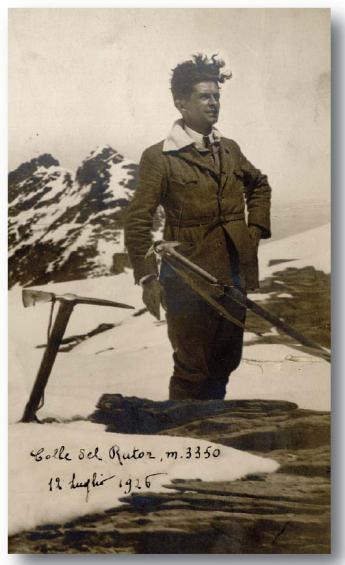
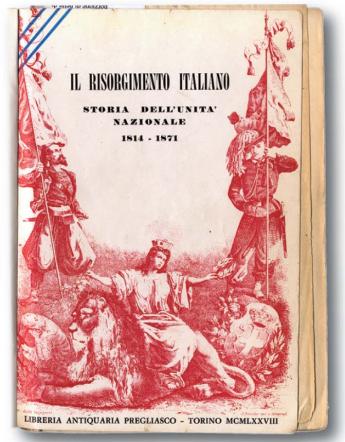
The Risorgimento
In 1978 the first catalogue published after the bookshop founder’s death, came with a dedication by his son, Arturo, and it was related to a great period of Italian History: the Risorgimento (no. 42). In the anniversary of the 150 years of the Italian Unification, we would have loved to represent this topic, but it would have been impossible to get close to the richness and to the quality of the previous one. The collection consisted of more than 2,200 items, mainly originating from the library of Francesco Fadini, a historian of the Risorgimento who was pleased to write a very nice introduction. Towards the end of the Seventies, Fadini almost took for granted to be able to trace a comparison between those years of turbulent changes and the Risorgimento, ending his writing with a wish for the future: “Also a good catalogue published by a smart antiquarian bookseller can offer a contribution for hope, non rhetorical invitation to accept and meditate on the lessons of the ‘days of our redemption’.
Italy, Its History And The Local and Regional Patrimony
Catalogue no. 22 (1968), Historia Patria, was dedicated to the different Italian Regions, and also no. 86, dealing with travels and local history. But offers about local history are really quite a few: Genoa and its rivieras (no. 51, 1984), Tuscany (1995), the imposing Milan and Lombardy through books, no. 77 and 80 with almost 1500 entries divided into two parts between 1999 and 2000; not forgetting the Piedmont catalogue and the recent Seven hundred books on Piedmont (no. 47 of 1982 and no. 94 of 2006). A different consideration should be given to Sardinia throughout the centuries (no. 58, 1989), due to the few books written about this splendid island. It consisted of 397 works and it was dedicated as “an act of love of a Piedmontese bookseller for an island that has been added by the Dukes of Savoy by mere chance, tolerated, suffered, but in the name of which, they wanted to dedicate their first own kingdom”. In the introduction, the scholar Carlo De Magistris di Castella observed “this rich private library, luckily kept intact ... and now presented by my booksellers (and book lover) friends, the Pregliasco family... will undoubtedly remain an useful bibliographic instrument and bate for additional studies”.
A book is like a garden carried in the pocket.
(Chinese Proverb)
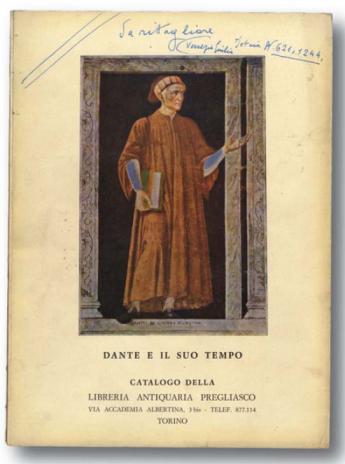
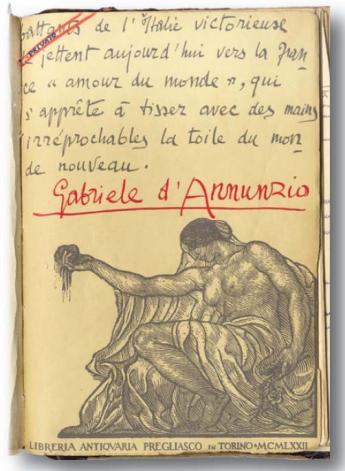
Comparing Collections
The comparison between catalogues of different periods, dedicated to the very same topic, does not become exhausted in one single episode, but is recurrent in the presentation of other monographic works. For example, on the Poet of the Comedy: Dante and his Time (1965) and Florilegium of Dante’s editions (2010). The first was published for the 700th anniversary of the author’s birth, while the second is currently being prepared with a voluminous addition and it will appear in 2011 for the 690th anniversary of his death. Dante and his Time (no. 13, with the subtitle The forerunners of the Renaissance - Jacopone da Todi, Guido Cavalcanti, Boccaccio, Petrarca, Cino da Pistoia, Cecco d’Ascoli, Brunetto Latini, Guittone d’Arezzo, Villani, Leonardo Aretino) consisted of 1,266 items and it earned a letter of appreciation from Pope Paul VI. Also in this case, it is worth mentioning the price of the Comedia by Bernardino Benali and Matteo Capocasa of 1491: the already considerable amount of 950,000 Lira (“with a very ruined binding”) in 1965 almost appears to be ridiculous if compared to the 55,000 Euro that are required today for a highly important copy with manuscript annotations added in the 17th Century and inspired by the relationship between Rosicrucianism and Dante; while for the Aldine of 1502 we pass from 240,000 Lira to 16- 19,000 Euro of the two copies presented in 2010.
A comparison can also be made between the two collections of loose plates of the Theatrum Sabaudiae et Pedemontii, presented in 1979 and in 2002, coming from two copies, both unbound, without any possibility of rebinding them once more as books, but presented in the whole of their illustrations. Giuseppe Luigi Marini defined the work in this manner in his introduction of 1979: “exceptional document of the baroque century and unsurpassed iconographic monument of the Savoy Duchy ... expression of culture and will of prestige in a minuscule State, true incunabulum of a publishing practice... Just like in a real theatre, where fiction and reality are intertwined, the 140 copper plates describe the Duke’s lands, without any immunity from baroque pompousness and rhetoric, with just a little bit of truth, that makes them, still as today, topographically identifiable, and with that touch of elation and amusing will, providing them with a touch of legend”.
Probably, the most significant example is Gabriele D’Annunzio, dedicatee of two catalogues published in 1972 and in 1996. The introduction of no. 33 by the late Franco Antonicelli, essay writer and personality of the anti-fascist movement in the Torino area, defines it “a precious collection presented for sale and a catalogue of refined pages”. Regretting, as a passionate scholar, that such collection “will go to the hands of different amateurs, for their incomparable pleasure”, in the end he consoles himself this way: “Too bad! It is already something important when you own a copy of this catalogue by the Pregliasco, a loving antiquarian booksellers family, honoured by quality researchers”. It is not by mere chance that the 1972 catalogue “didn’t pass unnoticed by bibliophiles, scholars and booksellers”, and was a precious reference for the editing of the pamphlet of 1996, which kept the suitable cover, although with a quite modern internal graphic.
Books serve to show a man that those original thoughts of his aren't very new after all.
(Abraham Lincoln)
Il Convivio: Books At The Banquet Of Knowledge
A new series was born in 1967, called Convivio, that was published once or several times a year until 1990. The title was inspired by the famous work by Dante, since with the treaty written in the distant ‘200 it was sharing the intent. The Convivio is an unfinished encyclopaedia of medieval knowledge, the title of which had been explained by Dante in the first chapter: the idea of preparing a metaphorical banquet where, in place of the food, the guests are presented with topics of knowledge. The choice of the “Vulgar” dialect of Florence embodies the desire to elevate common people to the serene table of the savants. Therefore, the idea for our Convivia was to present the public with series of books of different topics, but at an affordable price. Thus we began the tradition, that was renewed for a total of 23 years, to offer a small banquet of “knowledge” where the entrees often were quite particular – among many of them, we would like to remind you some of the most curious ones: aeronautics, gastronomy, ascetical religion, regional costumes, municipal history, hagiography, calligraphy, risings of 1921. The graphic outlook was willingly simply, but not without a touch of elegance. As a matter of fact, the title was framed by a xylograph of the Quadrivium by publisher Simon de Colines, to recall the four disciplines among Liberal Arts (Astronomy, Music, Geometry and Arithmetics), the study of which was propaedeutical to the most complex doctrines, such as Theology, Medicine and Law. The border is therefore metaphorical as it was included on the cover of the Convivio to serve as an introduction for the readers about the curious and the collectors of other more “educated” catalogues.

To be continued ...
Part 2 of "Living With - And From - Books: A Century of Manuscripts and Early Printed Books of Literature, Fine Arts, Science and First Editions", published by Umberto Pregliasco on the occasion of the 100th anniversary of the Libreria Antiquaria Pregliasco. The text is presented here by permission of the author.
>>> Libreria Antiquaria Pregliasco
>>> Celebrating one hundred years of Libreria Pregliasco - watch the video on Vimeo
